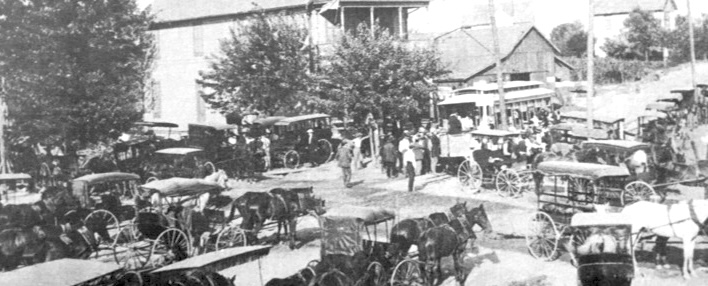Source 7.01: James E. James E. Clements’ map of Washington City and surrounding country. [Washington, D.C.: James E. Clements, ?, 1891] Map. Retrieved from the Library of Congress.
Source 7.02: Gedney & Roberts, and A. M Gorman. Perspective view of northwest Alexandria: showing location concerning cities of Washington & Alexandria. [Washington, D.C.: A.M. Gorman, 1890] Map. Retrieved from the Library of Congress.
These two posters (S7.01-2) show that real estate promoters invested in Arlington as trains and trolleys made suburban living more practical for city professionals. These are additional resources that make this point:
- Brewer, H. W, et al. Palisades of the Potomac, scenery unsurpassed: embracing the additions to Washington of Drovers Rest, White Haven, Toronto Heights, and River View, adjoining Washington and extending along the Potomac River on both sides of the Conduit Road for five miles to the Little Falls. [Washington: Palisades of the Potomac Land Improvement Co, 1890] Map. Retrieved from the Library of Congress/
- Averill, F. L, F. L Averill, and District Of Columbia National Guard. Engineering Platoon. A map of the District of Columbia and its vicinity shows the principal points of interest, including the present condition of the defenses of Washington. [Washington: The Platoon, 1892] Map. Retrieved from the Library of Congress.
- Gedney & Roberts, and Barnes & Weaver. Bird’s eye view of Barnes & Weaver’s addition to Brookland. [Washington, D.C.: Barnes & Weaver, ?, 1895] Map. Retrieved from the Library of Congress,
- H.W. Newby & Co, et al. Plat of Curtis & Burdett’s Carlin Springs, Alexandria County, Virginia subdivision: 260 ft. above sea level. [Washington, D.C.: Baxter & MacGowan: Matthew Trimble, 1887] Map. Retrieved from the Library of Congress.
- Howell & Greenough, et al. The first addition to Carlin Springs, Alexandria Co., Va. [Washington, D.C, 1890] Map. Retrieved from the Library of Congress.
Source 7.03: [Washington and Old Dominion Railway System Map]. ca. 1920. In Netherton, Nan, and Ross De Witt Netherton. Arlington County in Virginia: A Pictorial History. Norfolk: Donning Co, 1987. Print.
Source 7.04: [Glencarlyn Station, built 1890] In Arlington. Charleston, S.C.: Arcadia Pub, 2000. Print.
Source 7.05: [Bonair Station, built 1912] In Arlington. Charleston, S.C.: Arcadia Pub, 2000. Print.
Source 7.06: [East Falls Church Railroad Depot, ca. 1900] In Arlington. Charleston, S.C.: Arcadia Pub, 2000. Print.
Source 7.07: “Clarendon Circle about 1900 showing the station and in the background the fire station.” The Arlington Historical Magazine 4.4 (1972). Print.
Source 7.08: Tennyson, E. L. “The History of Arlington County’s Electric Railways.” The Arlington Historical Magazine 7.4 (1984): 39-48. Print.
These images and maps (S7.03-8) illustrate Arlington’s transportation-driven development following the Civil War.
Source 7.09: [A row of gambling houses and taverns, Jackson City]. [ca. 1904]. In Foster, Jack H. “Crandal Mackey, Crusading Commonwealth’s Attorney.” The Arlington Historical Magazine 7.4 (1984). Print.
Source 7.10: [The grandstand of St. Asaph’s race track]. [ca. 1904]. In Foster, Jack H. “Crandal Mackey, Crusading Commonwealth’s Attorney.” The Arlington Historical Magazine 7.4 (1984). Print.
In the early 1900s, Crandal Mackey led a campaign to rid Arlington of vice. These two pictures (S7.9-10) are of institutions Mackey shut down. You can read more about Mackey here.
Source 7.11: Harris & Ewing, photographer. Wright Brothers Airplane, Etc. Type A Plane at Fort Myer. 1909. Image. Retrieved from the Library of Congress.
Source 7.12: Bain News Service, Publisher. Govt. Radio Station, Arlington. [between Ca. 1910 and Ca. 1915] Image. Retrieved from the Library of Congress.
Source 7.13: Thomas A. Edison, Inc, and Kleine. Down the old Potomac. United States: Edison Manufacturing Co, 1917. Video. Retrieved from the Library of Congress
These documents illustrate Arlington’s connection to technological developments in the early twentieth century.
- Image. Retrieved from the Library of Congress
- Harris & Ewing, photographer. Wright Flights, Fort Myer, VA, July 1909. First Army Flights; Wilbur and Orville Wright, Charlie Taylor; Putting Plane on Launching Rail. July, 1909. Image. Retrieved from the Library of Congress
Source 7.14: Confederate Veteran Memorial. [1914]. Image. Retrieved from the Library of Congress.
This memorial was built at a time when the history of the South and the Civil War was being mythologized in films like “Birth of a Nation.” The sculpture in this memorial is an excellent example of Lost Cause ideology and a great gateway into conversations about race, memory, service, heritage, and political mythology.
Source 7.15: Washington Post, photo credit. “Newly Elected Officers in Arlington County.” In The Chronicle [Arlington] 6 Nov. 1931, 12.10: 1. Print.
In 1930, Arlingtonians voted to have a county manager form of government. In 1931, Arlingtonians voted for their first county board, including Arlington’s first woman to hold an elected office in Arlington (S7.15).

